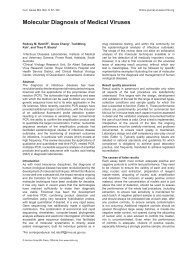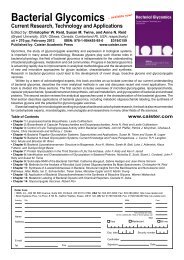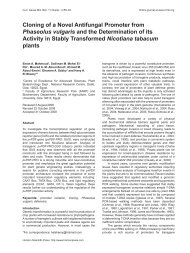Molecular Diagnostics of Medically Important Bacterial Infections
Molecular Diagnostics of Medically Important Bacterial Infections
Molecular Diagnostics of Medically Important Bacterial Infections
Create successful ePaper yourself
Turn your PDF publications into a flip-book with our unique Google optimized e-Paper software.
32 Millar et al.<br />
Table 6. Most common factors contributing towards false positive and false negative results in molecular diagnostic assays.<br />
Reasons for false-positive results Reasons for false-negative results<br />
Carry over contamination (amplicons) from previously amplified products Inhibition <strong>of</strong> PCR reaction<br />
Presence <strong>of</strong> exogenous target DNA in reagents, water, kits, sterile blood<br />
culture material<br />
Inadvertent loss <strong>of</strong> template nucleic acid target due to poor extraction,<br />
handling and storage protocols<br />
Poor primer design (non-specificity) Digestion <strong>of</strong> nucleic acid template with endogenous DNAses and RNAses<br />
Inadequate amplification conditions Poor primer design (non-conserved regions at primer site(s) in variants)<br />
Contamination from laboratory personnel Poor intrinsic sensitivity <strong>of</strong> nucleic acid amplification/analysis detection<br />
system<br />
Poor sensitivity <strong>of</strong> nucleic acid amplification/analysis reaction<br />
Poor specificity<br />
Inadequate amplification conditions<br />
a strong signal, due to high copy numbers <strong>of</strong> target. By<br />
employing these controls especially the negative controls,<br />
it is easier to identify the point <strong>of</strong> contamination within the<br />
diagnostic assay e.g., DNA extraction contamination free<br />
but contaminated at PCR set up stage. Positive controls<br />
are also important, particularly those included in the DNA<br />
extraction procedures, as they serve to identify possible<br />
inhibition <strong>of</strong> the PCR reaction, due to inhibitory agents in<br />
the biological specimen, which co-elute with extracted<br />
DNA, e.g. sodium polyanetholesulfonate in blood culture<br />
material (Millar et al., 2001). For a comprehensive review<br />
on PCR inhibition with respect to biological specimens,<br />
see Wilson (Wilson 1997).<br />
Standardization and harmonization<br />
Presently there are numerous molecular methodologies<br />
for the identification and genotyping <strong>of</strong> both culturable<br />
and non-culturable bacterial causal agents <strong>of</strong> infection.<br />
Although various commercial approaches have been<br />
described, such as the MicroSeq PCR-DNA sequencing<br />
identification system, the majority <strong>of</strong> methods used in<br />
clinical microbiology laboratories are “in-house”. To date,<br />
there has been little or no attempts made to standardize<br />
and harmonize bacterial detection protocols between<br />
laboratories at a local, national and international level,<br />
although several European centres have attempted to<br />
examine these for specific organisms (Struelens and<br />
others 1996; Deplano et al., 2000; Dijkshoorn et al.,<br />
2001; Fry et al., 1999; Grundmann et al., 1997; Van<br />
Belkum et al., 1998). The disadvantage <strong>of</strong> not employing<br />
such standardized methods may lead to anomalies in<br />
the epidemiologically, which may yield bias results and<br />
hence corrupt the epidemiological reporting <strong>of</strong> a variety<br />
<strong>of</strong> infectious disease states. Most diagnostic laboratories<br />
employ methods, which are not completely consistent with<br />
their peer laboratories, e.g. employment <strong>of</strong> a published<br />
method with variations in the empirical optimization<br />
and/or with different reagent suppliers. Presently, there<br />
are limited studies detailing the effect <strong>of</strong> such variation<br />
on qualitative reporting <strong>of</strong> results and hence this area<br />
requires urgent attention. More recently, various focussed<br />
attempts have been made to try to standardize bacterial<br />
subtyping techniques, through the actions <strong>of</strong> PulseNet<br />
(http://www.cdc.gov/pulsenet/), primarily for bacterial<br />
foodborne disease surveillance in the US and the ESF<br />
Network for Exchange <strong>of</strong> Microbial Typing Information<br />
European Network (ENEMTI) (http://lists.nottingham.<br />
ac.uk/mailman/listinfo/enemti). ENEMTI is a network<br />
<strong>of</strong> European laboratories that aims to standardize<br />
methods and data exchange protocols for internet-based<br />
comparison <strong>of</strong> microbial fingerprinting data. This project<br />
aims to develop an internet-based database system for<br />
DNA fingerprints that is readily accessible and userfriendly<br />
for microbiologists with only limited computer<br />
expertise. In addition, the European Society for Clinical<br />
Microbiology and Infectious Disease (ESCMID) have a<br />
specific working group, namely the ESCMID Study Group<br />
on Epidemiological Markers (ESGEM), whose objectives<br />
are to (a) critically evaluate microbiological typing systems<br />
and make recommendations for their appropriate use, (b)<br />
promote collaborative research into microbiological typing<br />
systems and to develop standardized methodology for<br />
specific pathogens, (c) provide a forum for the exchange<br />
<strong>of</strong> ideas and the development <strong>of</strong> consensus strategies<br />
and (d) work with individuals and companies active in<br />
this research area to foster the development <strong>of</strong> further<br />
technological advances in microbial typing (http://www.<br />
escmid.org/sites/index_f.asp?par=2.5).<br />
Appraisal <strong>of</strong> molecular diagnostics in clinical<br />
bacteriology<br />
<strong>Molecular</strong> diagnostics have several advantages and<br />
disadvantages for their adoption into routine bacteriology,<br />
as detailed in Table 7. At present, employment <strong>of</strong><br />
molecular diagnostics is largely confined to specialized<br />
or reference bacteriology laboratories, due to several<br />
factors. With such an approach, molecular methodologies<br />
including PCR, real-time PCR and PFGE may have<br />
the opportunity to become adopted by several regional<br />
diagnostic laboratories outside <strong>of</strong> highly specialized<br />
reference facilities, as such methodologies have been<br />
shown to provide valuable real-time information to aid<br />
in outbreak management and identification <strong>of</strong> nonculturable<br />
or fastidious organisms. To date, the speed in<br />
which these assays have been taken up has been closely<br />
related to the relative skills base within the laboratory,<br />
thus although there is an advantage in all hospital types<br />
utilising such technology i.e. from the district general to<br />
university teaching hospitals, such techniques have not<br />
become common where the skills base does not exist.<br />
Furthermore, there is the added danger that hospital<br />
research facilities, which have been the custodians <strong>of</strong><br />
these research techniques to date, become overloaded<br />
with a molecular diagnostic workload, simply because<br />
they have the necessary skills base. In addition, molecular<br />
techniques are perceived to be relatively expensive,<br />
which is the case on a simple head-to-head comparison<br />
(Table 8). The overall value <strong>of</strong> the quality <strong>of</strong> the test result,





